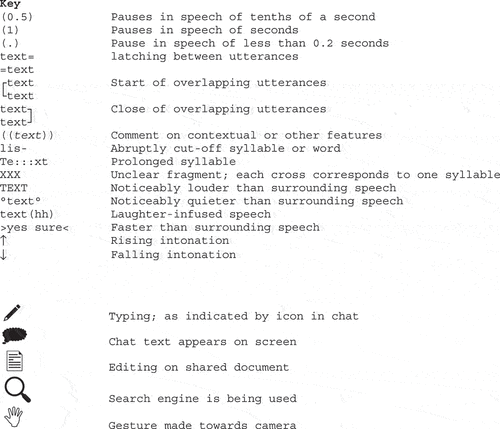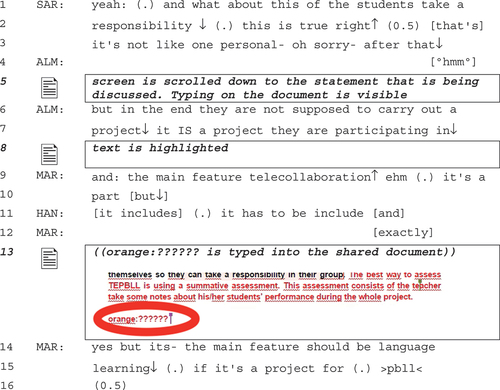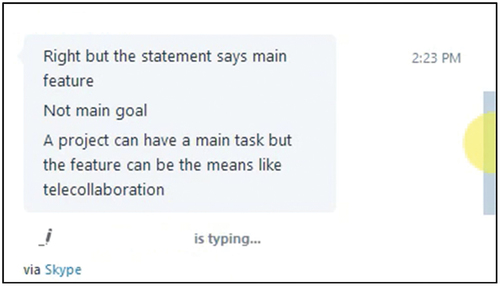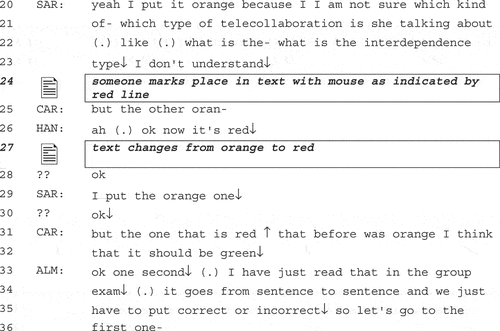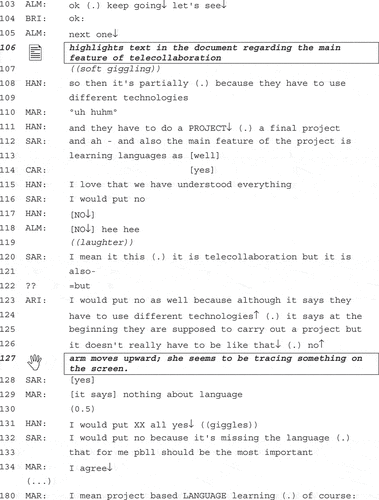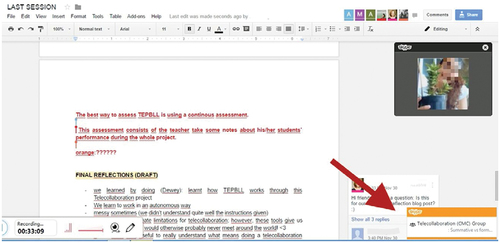ABSTRACT
This paper takes a multimodal conversation analytic approach to explore knowledge-in-interaction in a technology-mediated online environment (Skype videoconference) during a meeting between eight university students studying to become language teachers. The analysis considers the ways in which the student-teachers demonstrate their knowledge or understanding of telecollaborative project-based language learning while taking part in a telecollaborative exchange themselves. Given the growing predominance of online teaching and learning, it is increasingly relevant to have a deep understanding of the ongoing learner interaction that takes place in these environments, particularly considering that interaction can be understood as a trajectory of knowledge building. The study examines how the student-teachers make use of the different technological features of a videoconferencing platform to manage the assigned task, which is to complete a collaborative exam. These features include camera, shared links, parallel text chats and editing tools. Findings imply that the student-teachers sequentially organise their knowledge synthesis and co-construction of pedagogical understanding through technologically-supported mutually coordinated interaction. Although the analysis is contextually bound, the task-focused interaction that is highlighted is relevant to higher education teachers in a variety of contexts, apart from teacher education.
1. Introduction
Social constructivist theories have long suggested that in order to meet current educational requirements learning must be collaborative and social (Todorovski, Nordal, and Isoski Citation2015). Current educational needs, according to a commissioned report (Johnson et al. Citation2015), include the need for more flexible learning environments that involve more participants and break with teacher-student(s) only models. Even before the Covid-19 pandemic, many educators had begun to integrate online collaboration into their pedagogical design. Known as telecollaboration, or more recently Virtual Exchange (VE), this practice has been explored more frequently in higher education (Evaluate Group Citation2019) although there are a growing number of documented practices in secondary and even primary education levels (Dooly and O’Dowd Citation2018). Additionally, other online learner work such as ‘flipped instruction’ (Johnson et al. Citation2015) has opened up new pedagogical venues, bringing further emphasis to the need for a deeper understanding of online learner interactions.
With the global pandemic of Covid 19, online interaction in learning environments has soared due to confinements and school closings around the world, making manifest the need for in-depth analysis of the different levels and types of online patterns of interaction aimed at supporting collaborative learning. Out-of-classroom, online exchanges are a particular challenge due to limited access to visual and physical support of social interaction processes that typically occur when interactants are bodily present (tactile input; corporal movements that may be too minuscule to be captured by camera or are carried out off-screen in videoconferencing and so forth). Support is limited, too, by the spatial distribution of participants, whose movements must be constrained to camera-range dimensions; the scope of access to one another’s physical context in which they are co-present is far smaller than occurs for interactants in the same physical space (Luff et al. Citation2016). Learners can only access the other participants’ local setting through the computer screen. This contrasts significantly to the shared local setting that takes place in face-to-face settings and which helps participants establish recipiency and intersubjectivity (Sert Citation2015).
Studies in educational settings have found that learners are often creative in finding solutions to these limitations (Brunner, Diemer, and Schmidt Citation2016). Nonetheless, in this study, an additional constraint for the students is the pressure to autonomously complete assigned collaborative tasks outside of the normal (f2f) classroom context (Dooly and Tudini Citation2016). These are the parameters of the fragments that are presented here. The data are from a video-recorded weekly meeting of a small group of student-teachers from two geographically distanced universities. The students are learning to become language teachers (mostly English as a Foreign and/or Second Language although there are some studying to become teachers of other languages). Applying a multimodal Conversation Analysis (CA) approach to the data, the study aims to ‘unpack’ the multi-layered interaction in the technology-mediated online environment in order to observe what the student teachers (ST) attend to and to provide insight into how they make sense of what they are saying and doing (Schegloff Citation2007). Applying CA to recordings of meetings in which no teacher is present allows us to explore how knowledge and learning are co-produced between the STs in student-led situations, specifically, how they organise and manage their interaction through the multilayered resources (technological, visual, aural, verbal, gestural). The analysis aims to offer a rich description of complex interaction between the participants as they make sense of each other’s turns while also bringing to the foreground methodological challenges – spatiality, temporality, modality, when dealing with online interactions.
2. Theoretical background
There has been significant and relevant CA research into language education (see Huth Citation2020 for a review); however, the principal focus of much of this body of work has been carried out regarding interaction in face-to-face (f2f) classrooms. There has also been significant CA work into online interaction (see Meredith Citation2019 for a review). But, there have been fewer CA studies on language teacher education in online interaction. Understanding the ways in which students collaborate and maintain progressivity in the achievement of tasks in online environments, in particular, when teachers are not present as occurs in ‘flipped instruction’, is becoming increasingly important. This approach, along with telecollaboration, has even been hailed as two of the six key trends for impactful change in higher education (Johnson et al. Citation2015). Both approaches require significant learner autonomy. As unsupervised individual and group digital work assignments become more ‘normalized’, the ability to negotiate and sustain on-task interaction must be taken into consideration when designing learning ecologies – even when teachers are not present. This indicates a need for more research into online interactions such as those presented in this study.
The pedagogical approach for the online interaction that is examined in this study is commonly known as telecollaboration or Virtual Exchange (VE), combined with extensive flipped instruction. Even before the pandemic of Covid 19, telecollaboration had been a growing trend as teachers and students become more familiar with the use of communication software such as Skype, Google Meet or Zoom, in particular in language teaching, as it provides the opportunity for learners to ‘connect’ with other users of the target language from different geographical locations. Many definitions have been proposed for telecollaboration. For the sake of brevity, it is understood here as a teaching approach, supported through the technological features of diverse digital communication tools (e.g. cell phones, tablets, computers), with pedagogical tasks and activities that are collaboratively designed, implemented and assessed between more than one teacher. Recently, there has also been an increase in studies on telecollaboration in teacher education (Dooly and Vinagre Citation2021; Evaluate Group Citation2019). However, there have been far fewer studies on the interaction that takes place between student-teachers during telecollaborative exchanges (Dooly and Tudini Citation2016).
In any environment where the participants are required to communicate and collaborate, the participants must create a mutual interactional space (Mondada Citation2009). In a digital environment such as the one being used for this telecollaborative meeting, it can be argued that the mutual interactional space constitutes an even more complex situated context because the technologically mediated communicative spaces are both global and local, intersecting in a hybrid and simultaneous manner (Messina Dahlberg and Bagga-Gupta Citation2014). Similarly, in their work on video-mediated environments, Luff et al. (Citation2016) found that ‘despite all participants appearing to have very similar resources available to them (…) the technology actually produces different ecologies of action for each participant’ (p. 356). These same authors underscore the video-mediated possibilities that permit distanced communication with accessible cues that are found in face-to-face interaction such as facial movements and limited bodily gestures (what can be captured by the camera). This limited access may even become an embedded part of the interaction (Luff et al. Citation2016), for example when a participant holds an object up to the camera for others to view (Licoppe Citation2017).
Luff et al. (Citation2003) refer to the video-mediated environment of platforms such as the one used by the group members in this study (Skype) as fragmented ecologies, which are mediated through dual-focused cameras and screens. Given that a key aim of interactional analysis is to understand how the participants make the structure and segments ‘visible’ to others; for instance, the way in which the participants collaboratively open, sustain and then signal the closure of a segment in order to move on to another one of differing nature), it is relevant to bear in mind the possibilities and constraints of the digital interactional space (Dooly and Tudini Citation2016). Referencing of salient points that may not be visually available to all participants in an online platform may require more verbalisation (Yu and Tadic Citation2020) or the use of other modalities, especially in educational contexts involving an assessment task, where clear communication is paramount.
In this study, we look in particular at the ways in which the interactants co-organise themselves, making use of the available multimodal features in the online platforms (video livestreaming, shared online documents, text chats), in order to complete their assigned task. We do so by tracking the sequential organisation of their interaction (Streeck, Goodwin, and LeBaron Citation2011) as it is mediated through the technology. In an online telecollaborative environment where students are expected to take control of their learning, this co-organisation and collaboration are especially relevant. Features of ‘collaborative’ interaction within a ‘computerized’ environment have been a point of discussion for over forty years now (consider Kling and Scacchi’s work on the social impact of computing in the 1980s). However, the application of a microanalytical focus on online exchange that takes into account turn-taking, spatial organisation as well as the interaction with other non-human artefacts (text messages, shared documents) can help provide important insights as educational contexts move increasingly towards blended and fully online environments. Advances in technology with features that can promote ‘intimacy-at-a-distance’ (Licoppe Citation2017, 64) provide researchers insight into ‘embodied interaction’ in online educational environments. Thus, we can better understand how features of the environment are ‘referred to, animated, and manipulated within an ongoing interaction’ (Luff et al. Citation2016, 343) and have more fine-grained insights into co-construction of knowledge in these ecologies, to guide future online teaching efforts.
3. Methodology
This study focuses on an online meeting between a group of eight STs completing an online exam collaboratively. The meetings, which ran over 10 weeks in which the course calendars overlapped, were made up of 2 to 3 members from each partner institution. Each meeting had varying instructions and expected outcomes, including group project creation and the production of materials to share with their in-class colleagues. This article focuses on the last meeting of the group, in which they were asked to work together on an exam on key concepts dealt with throughout the course, followed by short social activities to close their telecollaborative sessions. Because the entire course had focused on the importance of collaborative learning, this exam was designed to be answered together between the members of the group. The participants had written the questions and answers in a class activity a few weeks earlier, while working on a task entitled ‘what we know and what we still need to know’, but at that time they were not aware that they were co-creating this exam. The first activity’s outcomes contributed to a compilation of key questions about the course, along with a variety of responses, all of which were refined by the course teachers and then used for the final exam. Each group had different, but similar exam questions to discuss. The exam format consisted of ‘drop down’ answers, which the group members had to discuss and then select the most appropriate response.
The data to be analysed were chosen for various reasons. Firstly, this final meeting focused on the participants’ assimilation of the course contents. Through their discussions regarding the exam questions, the synthesis of their knowledge is more visible than in prior meetings. The task lends itself to more explicit verbalisation of references to previously acquired information while allowing for visible ‘building on’ this knowledge. Secondly, at this point in the course, the participants were familiar with each other and with the online meeting procedures. Data from earlier meetings would have provided useful insights regarding how the participants work through the process of getting to know each other and the technological constraints of online learning environments but that would be a focus for a different study. Finally, this particular meeting was chosen for analysis because of the clarity of the recording. As Hoey and Kendrick (Citation2017) indicate, almost any naturally occurring data are theoretically available for CA; however, some data presents challenges because of audibility or visibility and render the analysis less reliable. This group’s data provided the most reliable raw data for transcription.
After transcribing the meeting, using a multimodal CA perspective (Sacks Citation1995), the extended sequence was analysed and selected excerpts were chosen for a more detailed sequential analysis (Schegloff Citation2007) with the aim of exploring how the STs’ turn-by-turn actions reveal co- produced knowledge exchange through sequential and mutual orientation. The excerpts are all related to negotiations during the completion of the collaborative exam.
For this study, we have adapted Musk’s (Citation2016) protocols to display simultaneous modes of action, when these moments are available in the data (see appendix for the full key).
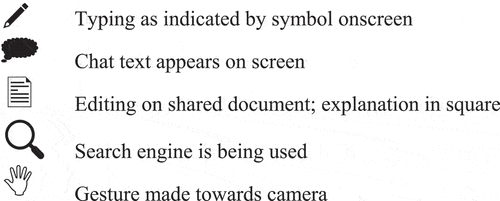
Identifying exact moments of some of the actions was not always possible in a single recording of a videoconference as the scope is limited to what is captured by the recording computer (recording was the responsibility of only one participant per meeting). For instance, exact moments of some actions such as typing by other participants may not be evident until a message appears on screen (however, sometimes they are indicated in the text or other times typing can be heard). Editing on a shared document by co-participants may be visible as the text will appear as it is typed, although even these actions are dependent on the speed of the Internet connection of the computer recording the interaction (there may be lags). They also depend on whether the recording captures the place in the document where the editing is being done since the person recording may scroll up or down and the position of the document on the screen is what appears in the final recording. All lines are numbered so that there is no prioritisation of one modality over another (Musk Citation2016). We have included screen captures in the transcriptions to visually support the understanding of the interaction. Captures that provide greater detail as larger images are included as figures outside the transcriptions.
The entire meeting lasted for 1 hour, 53 minutes and 4 seconds. Three fragments were selected, pertaining to moments of negotiation of the answers for the collaborative exam. These are presented in this article with a subtitle as introduction. Because the fragments are long, they are presented in smaller segments, referred to as excerpts. Thus, fragment 1 (Colour-coded editing as part of the interaction) is analysed in Excerpts 1a, 1b, and 1c. The rest of the fragments are dealt with similarly.
The participants are student teachers from two different universities; one group is located in Spain, the other in the United States. They are taking part in a collaboratively designed curriculum (designed, implemented and evaluated through co-teaching between both teachers at the two universities). The students are not at the same level. They are made up of undergraduate preservice teachers in Spain, studying to become English (as a foreign language) teachers and MA students enrolled in an applied linguistics course, specialising in language teaching in the USA. The students had met on a weekly basis during a semester as part of the course requirements. The students were given freedom to decide which communication platform they preferred, and they chose to use the Skype platform. The meetings usually lasted 1.5 to 2 hours. Each meeting had set instructions for a variety of tasks ranging from preparing activities for upcoming online meetings, preparing materials for other groups’ online meetings or for in-class activities or working on their group final output (designing of a technology-enhanced, telecollaborative language learning project). In this final meeting, they have been assigned a collaborative exam which required them to read and discuss the questions, negotiate their answers and post them in the online form. The online exam gave them immediate feedback once an answer was submitted by the group. The intended aim of the exam was principally to support dialogic reflection and synthesis of content learnt during the telecollaborative exchange, not to quantify correct or incorrect answers. Different from other (individual) exams, this one was not as high-stakes as it might have been in other circumstances in which the learner is being assessed alone, based on their capacity to recall content in a classroom. In such circumstances, typically the students are expected to work solitarily and in silence and cannot dialogue with others regarding how they interpret the exam questions.
The participants in this meeting are USA-based members Ricardo and Brittany, and Spanish members: Hanna, Alma, Ariana, Marla, Carla, and Sara (these last two are at the same computer terminal). Their names have been anonymised, and all nominal references (tags in the chats) have been removed from the images. The images have been pixelated. All the participants gave written consent for use of the recordings for publications and teaching materials. The recordings were done by the participants during each meeting. This final meeting was recorded by Ricardo.
4. Analysis
4.1. Fragment 1. Colour-coded editing as part of the interaction
In the first fragment, the participants have begun working on the collaborative exam. Alma had previously created a shared Google document and copied the questions from the original exam. The shared document is being edited simultaneously by all the members in the meeting, but Alma is doing most of the typing. The unfolding of the action includes both talk and visible editing of the document, carried out by more than one person.
The group members are working on this discussion question:
Imagine a student-teacher has written this short essay about TEPBLL (Technology-Enhanced Project Based Language Learning). As a teacher, which of the sentences would you mark as correct and which ones as incorrect?
In Excerpt 1a, they are debating the appropriateness of a text that can be found in the shared document () which Alma has copied directly from the exam and pasted into the shared document. The students’ task is to ‘evaluate’ the fictional essay.
However, at some point, an unknown editor had begun to highlight words in the text in different colour fonts: green, orange and red. The use of colour coding was not part of the instructions; the use of colours appears to be related to green = correct statement, red = incorrect statement while the use of orange is not clear (as seen in ). This use of colour coding was not verbally agreed upon by the participants and, as will be seen further on, eventually leads to a point where they try to make sense of what is going on.
Excerpt 1a. Working on the shared document: orange?
In line 1, Sara provides a verbalised visual (Yu and Tadic Citation2020) of the text ‘what about this of the students take a responsibility’ before seeking confirmation that the statement is correct, (‘this is true, right?’ line 2). In lines 5 and 6, Alma suggests a reformulation of the text. At the same time, someone has highlighted part of the text that reads ‘Students are supposed to carry out telecollaboration’, which prompts Marla to suggest an expansion for the end of that sentence in lines 9–10. She reads out the problematised portion of the sentence first, thus orienting the other participants’ attention to that part of the text in the shared document. As Luff et al. (Citation2016) explain, in these environments the participants need to be sure that the other participants orient towards identified objects that form part of the telecollaborative sequence of actions.
Her preface with the token ‘but’ sets up a post-expansion; however, Marla is pre-empted by Hanna who overlaps her turn: ‘it includes (.) it has to be include and’ (line 11). Marla then provides an overlap resolution device – ‘yes’ – before continuing her explanation of why she feels the text is inaccurate while simultaneously displaying her knowledge regarding the features of TEPBLL: ‘The main feature should be language learning’ (lines 14–15).
Concurrently, someone types the word ‘orange’ followed by six interrogation signs below the text (see, Excerpt 1a above), while Brittany is posting messages related to the oral discussion (). Soon after the closing of this sequence, which is focused on the features of a TEPBLL (with the emphasis on language learning, as pointed out by Marla), the font colour coding is made relevant by other participants.
Excerpt 1b. Working on the shared document: why it is orange.
In line 18, Hanna displays her uncertainty regarding the colour coding that is being used by one of the participants to edit the document. She reiterates the question that had just been written on the shared document itself (orange ??????) and in line 19 Carla seems to have a similar doubt.
Hanna’s request for clarification about the coding initiates another collaborative epistemic search, which begins with a discussion of the use of the colours and leads into a broader debate regarding types of telecollaboration.
Excerpt 1c. Working on the shared document: I think it should be green.
In line 20 (Excerpt 1c), Sara first explains that she is the one who has changed the colour of the text to orange because she is not sure ‘which type of telecollaboration is she talking about’ (line 20). She then expands on her doubt: ‘what is the- what is the interdependence type (.) I don’t understand’ (lines 22–23). Sara hedges her disagreement but at the same time identifies the answer as potentially incorrect and orients the interaction to elicit further explanation and elaboration. However, the possible sequence expansion does not occur. Instead, in line 25 Carla starts to point out that there are other parts of the text that are also marked in orange; she is then interrupted by Hanna (line 26) who indicates that the text is now red. This appears to be an embodied acknowledgement that they have collaboratively decided as a group that the sentence is incorrect.
Almost immediately, Carla problematises another sentence in the text (line 31), using a downgrading marker of ‘I think’ while at the same time asserting a certain level of epistemic primacy regarding whether the statements are correct or incorrect: ‘but the one that is red that before was orange I think that it should be green’. This downgrading with ‘I think’ is not uncommon in activities with a task-oriented goal in which participants are trying to establish mutual agreement; as Kärkkäinen (Citation2003) has pointed out, the marker may be used to display a new perspective on the same topic. The other members of the group appear to accept this shift in perspective as closure to the sequence, despite the non-resolution of Sara’s previous request for clarification on the meaning of interdependence (the topic is not brought up again in the exchange). In line 33, Alma initiates a new topic bid and the topic of the exchange now turns to how to complete the exam.
This excerpt underscores the highly complex multi-layered multimodality that constitutes the intersubjectivity of the participants in the online environment, as they complete the exam. Participants’ use of and orientation to coloured fonts indicate that this is a new technique that they use confidently but are still coming to terms with, based on their verbal negotiations and clarification requests.
4.2. Fragment 2. Making knowledge observable through text chat
In the turns prior to fragment 2, the participants had gone through the questions quite quickly, deciding and marking rapidly ‘correct’ or ‘incorrect ‘in the online exam.
Excerpt 2a. Discussion of the exam questions: I would put no.

Between lines 103 and 114 there is a rapid succession of declarative sentences punctuated with short affirmative agreements from different participants in the discussion. There is also clear indexicality between the notions regarding the features of telecollaborative projects that emerge in their answers and the much longer discussion a few minutes earlier during which the students were colour-coding their answers (Excerpts 1a and 1b). In line 115, Hanna offers an enthusiastic assessment of the co-constructed process up to this point as she reflexively orients to the work done so far: ‘I love that we have understood everything’.
However, this dynamic of quick general consensus of answers is halted when Sara makes an explicit delay to the progressivity of the interaction: ‘I would put no’ (line 116). Her utterance elicits very loud, overlapping repetitions of ‘no’, as if in disbelief, followed by laughter. In line 120, Sara offers an explanation, while using markers to downgrade her epistemic stance: ‘I mean it this (.) it is telecollaboration but it is also-’. Despite a token interjection of ‘but’ by one of the participants (line 122), Ariana soon aligns with Sara’s utterance (line 123), displaying an orientation to epistemic rights through a display of relevant and very detailed knowledge of TEPBLL, with an expansion on her explanation in lines 124–126. Ariana seems to trace something on her screen (line 127). Sara and Marla then orient towards Ariana’s hesitancy about the incorrectness of the earlier exam answer and contribute other reasons why it may be wrong (it is missing language focus, lines 129; 132–133). Marla completes the sequence with ‘I agree’.
These contributions initiate a vigorous discussion sequence regarding the key features of telecollaborative project-based language learning between lines 180 and 200. During this time, the text chat indicates that Brittany, who up to the point has been a mostly silent partner, is typing a message, which appears between lines 196 and 198.
Brittany’s message is not referenced immediately, but as the participants read it, the message triggers different responses from the others as explained in Excerpt 2b.
Excerpt 2b. Discussion of the exam questions: one thing.
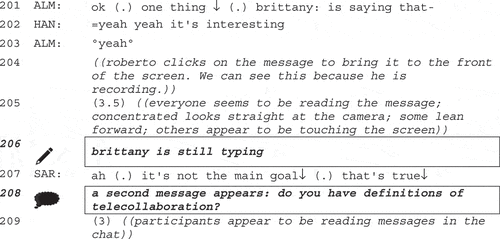
In line 200, Alma references Brittany’s typed message; she is interrupted by Hanna, who also references the chat message (turn 202). Alma and Hanna seem to orient differently to the message. Alma begins to formulate the message verbally (lines 201, ‘brittany: is saying that-’) while Hanna is assessing the message as ‘interesting’. These actions are immediately followed by the physical foregrounding of the message by Ricardo as he clicks on and brings up the message on the screen (line 204). At the same time, there are verbal indications of orientation to the text by other participants: ‘ah (.) it’s not the main goal (.) that’s true’ (Sara, line 207). The participants’ orientation to the screen as they read is visibly different from other moments when the discussion is more fluid: there are longer moments of silence, some of them have fingers pointing to the screen, some lean closer to the screen so that only the top part of the head is visible, eyes move across the screen. All of this embodiment seems to indicate that everyone is engaged with the written message.
Brittany’s use of a text chat, which is a communication channel that is not usually found in in-class discussions, contributes to the epistemic progress of the group’s work; however, Brittany, who has been mostly a silent participant up to this point, expands on her contribution verbally a few lines on.
Excerpt 2c. Discussion of the exam questions: we were RIGHT.
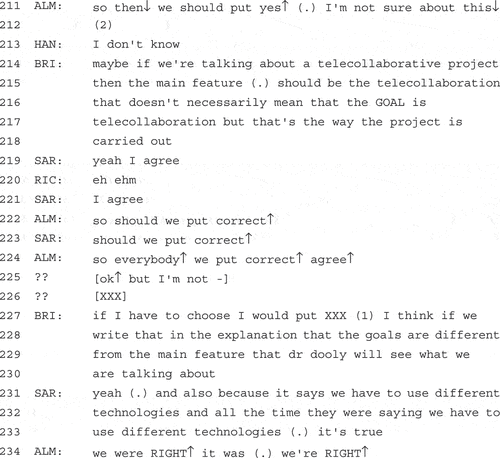
Hesitation markers by both Alma and Hanna (‘we should put yes; I’m not sure; I don’t know’) and two seconds of silence prompt Brittany to deliver a longer turn (lines 214–218) in which she explains her reasoning. Her contribution is partially accepted by the group; so she then expands on it in lines 227 to 230. Sara orients to this expansion and expands on it as well (lines 231–233). Alma ends the sequence with the exclamation: ‘we were RIGHT (.) it was (.) we’re RIGHT’ (line 234), followed by laughter and the successful closure of the sequence (and the task).
Brittany’s use of text chat clearly provided a scaffold for the ensuing verbal discussion by making participants’ discussion observable in writing, rather than relying entirely on voice, which is a rapid fade form of communication. The alternation between text and voice chat contributes to the progress of the online examination, with the text chat as a key affordance for learning in the Skype platform.
4.3. Fragment 3. ‘Continuous assessment’ online search: affordances for interaction and learning
In this last fragment, the students are discussing this statement: The best way to assess telecollaborative projects is through continuous assessment. They are having difficulties deciding whether continuous and formative assessment are the same. During several turns (not shown here), the group discusses the meanings and differences between continuous and formative assessment and the sequence appears to be very near closure with an agreement that they are synonyms. However, Sara then expresses some doubt that they are synonyms (line 1), and this hesitation appears to be validated by Ricardo’s elongated ‘ehm’ (turn 4) despite the two affirmative responses following Sara’s question: ‘I think so’ and ‘yeah’. Sara and Alma continue putting forth the idea that continuous and formative are the same and therefore the answer to the exam question is true (lines 6–8).
In line 9 (and above), Brittany posts a link for consultation in the text chat; however, there is no indication (in any modality) from the others to indicate that they have opened the link.
Alma pushes for an affirmative answer from the rest of her peers in lines 12 and 14, both turns being separated by a very long pause of 5 seconds. Ricardo then clears his throat (line 15), appearing to preface his upcoming utterance in lines 18–19 in which he uses an interrogative as an interactional device. Ricardo opens with an introductory move (a question: ‘you sure ↑ continuous assessment is the same as formative assessment↑’) in order to address a potential object of trouble – in this case he puts in doubt that continuous and formative assessment are the same.
Excerpt 3a. Discussion of assessment: ehm::::.
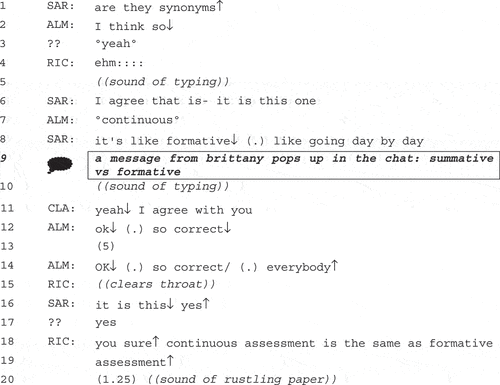
Ricardo’s turn is followed by a rather long pause of 1.25 seconds during which several of the participants avert their gaze from the screen and look downwards. The long pause and sound of papers rustling can be heard in the background (line 20), indicating a halt in the progress of the sequence and a seeming search for more information in notes or class materials taken or printed on paper.
In the next excerpt, in line 21, Alma initiates a sequence repair, which not only ‘re-starts’ the progressivity but seems to be an embedded censure of any further dispreferred responses by Ricardo.
Excerpt 3b. Discussion of assessment: we should google that.

In line 22 Brittany provides a mutual ratification of both Alma’s and Ricardo’s epistemic positions and in line 23, Ricardo ostensibly agrees with the notion that they are synonyms. However, after another pause, Ricardo articulates a proposal that they ‘should google that’ (line 25). While his proposal is mitigated with a laughing voice, he then proceeds to open up the browser and conduct the search (lines 32, 38). Ricardo seems aware that his proposal is a dispreferred response and in non-alignment to the epistemic stance that Alma has taken and perhaps this is why he deploys a mitigated directive-related social activity (we should google that) in order ‘to get someone else to do something’. (Goodwin Citation2006, 515). Interestingly, he is the one who follows his own directive, opening up the browser and typing in the words ‘continuous assessment’.
Through several turns (including before this fragment) Alma has positioned herself with epistemic authority. However, this position has now been problematised by Ricardo and in lines 22 and 33 Brittany begins to show non-alignment to the notion that the two terms are synonymous. Then, in line 27, Brittany inserts an unmitigated, seemingly disjointed utterance, ‘ I think they’re different’, indicating a complete change of epistemic status that does not seem to follow a sequential pattern.
Brittany’s utterance can be understood more completely as part of the ‘on-going, contingent accomplishment’ (Garfinkel Citation1967, 1) of ‘knowledge-in-interaction’ (Bateman and Church Citation2017, 3) if we consider the more complete picture of the actions taking place during these turns. Looking at the multilayered technology-mediated activities taking place in this sequence, we can observe that various digital features contribute to the changing epistemic status of the participants (Balaman and Sert Citation2017). Throughout the fragment, four participants are editing the document (with colour-schemed annotations); at least one participant consults paper format documents (probably class notes); a participant poses a question in a text chat inside the Skype platform, and this same participant makes reference to a document available from the course (evidenced through a second pop-up on screen). Alongside these group-oriented actions, Ricardo takes several individual actions to carry out a search for different definitions of continuous assessment (without any verbal interactions): he opens the search browser, types in the words, brings up several entries, selects one, hits return on the browser, selects another entry, highlights a definition and then pastes the definition in the text chat.
Brittany’s fourth and somewhat categorical utterance in line 47 (Excerpt 3b) comes a few seconds after Ricardo has posted the definition in the text chat. Then, in line 49 (Excerpt 3c) she verbally references his post.
Excerpt 3c. Discussion of assessment: ok i’m just reading.
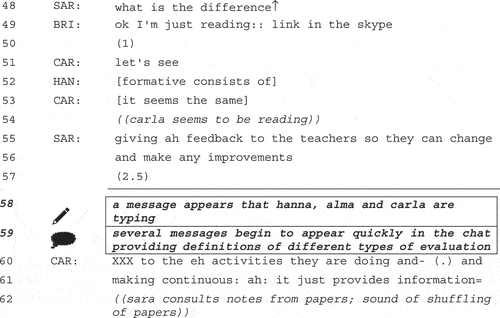
Borrowing Recktenwald’s (Citation2017) notion of ‘pivoting’, arguably we have an identifiable ‘turning point’ in interaction: Ricardo’s initial verbal challenge of the epistemic stance of the team followed by his embodied/online interactions of searching and posting a definition contributes to change the focus and progressivity of the interaction.
The group members appear to orient towards Ricardo’s (prior) action proposal to gather more information (which he carries out) and then begin to reformulate the group answer after he posts a definition. Other participants follow Ricardo’s embodied interaction with the posting of more definitions, links and opinions, most likely having also conducted an online search regarding the term continuous assessment while Sara refers to her class notes.
In the next Excerpt (3d), Brittany initially displays her disagreement with a definition proposed by Hanna, prefacing with the contrastive marker ‘but’ (lines 68–69).
Excerpt 3d. Discussion of assessment.
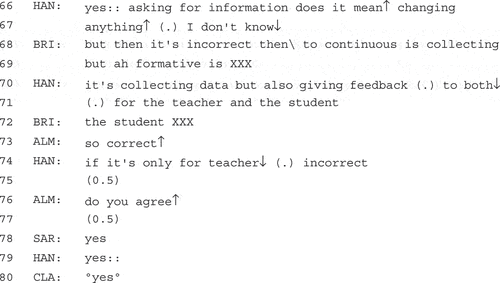

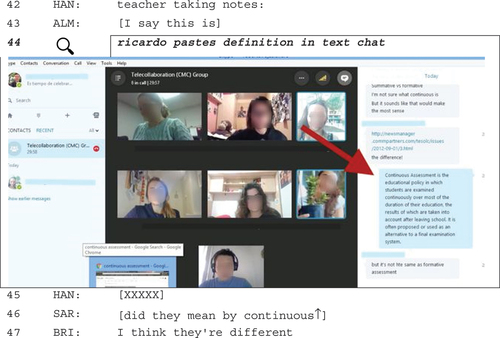
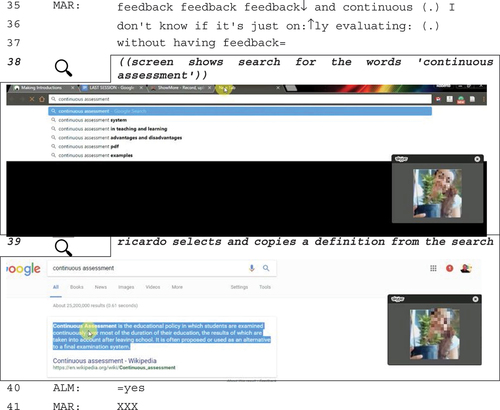

In lines 70–71, Hanna accepts Brittany’s repair with an expansion of the definition; this initiates a shift towards the closure of the sequence, which ends in both verbal and embodied agreement, articulated through gestures of ‘high five’ (line 85) and mediated through the camera of the platform. These ‘co-expressive gestures’ (Licoppe Citation2017) display a mutual conclusiveness to the progression of the sequence, while promoting affiliation between participants.
Analysis of interactions in Excerpts 3a to 3d indicates the changing epistemic status of participants as they collaboratively work towards an understanding of the notion of ‘continuous assessment’. They avail themselves of the affordances of online searches to achieve understanding and of the Skype chat tool to share knowledge gained with other participants.
5. Conclusion
Focusing on a collaborative online exam task, we have highlighted how online educational environments, which are becoming increasingly more common in education, require participants (and researchers) to re-think the impact that the technological features of the online venue may have in shaping the ensuing interaction. Conversation analysts have duly demonstrated that the physical characteristics of the venue are important for how the resultant interaction takes shape; however, we now find ourselves analysing data where the physical possibilities and limitations are difficult to define (Tudini Citation2020). Our analysis concurs with the numerous other studies that have shown that the mediation through technology, with its possibilities and constraints, will have an impact on the interaction.
The participants’ interaction is closely coordinated through talk and other multimodal resources such as the text chat, camera or the text colour editor tool in the shared document. The participants’ orientation to these technological artefacts are made mutually available for everyone during the interaction in the ‘dynamically evolving “gestalt contexture”’ (Licoppe Citation2017, 64) of their online meeting. Moments of confusion were quickly flagged – both through written and oral interaction – and this indexicality often led to mutually constructed epistemic search sequences. There were several incidents in which the participants identified a technological feature (colour text editor, text chat, links, camera) and adopted it to mutually accomplish their goal of highlighting temporarily agreed upon markers during the decision-making process and collaborative information search sequences.
Participants’ spontaneous orientation towards and discovery of technological affordances have implications for online teaching. These tools and how to use them constructively should be highlighted by educators for future participants of subsequent online collaborative coursework such as this exam, to continue to improve communication and group work in these settings. These findings also suggest that online examinations can be an effective means of promoting dialogue and negotiation of content understanding. This type of collaborative work could be better scaffolded by educators, based on knowledge gained in this small study. While the analysis presented here is context-bound, the findings are of interest to instructors working in online contexts outside of teacher education. Understanding the affordances of the technology from an educators’ perspective is important; however, equally significant is insight into how students use the assigned tools for completing the tasks, often in unexpected and innovative ways.
That these sequences occurred in an environment where there is no ‘official’ teacher supports the argument for further investigation. We can observe, in the unfolding action of the meeting, how one of the participants quickly positions herself as the ‘proxy’ teacher, by creating a document to work on beforehand, and taking great care to ensure there is a mutual understanding of both the parameters of the tasks that are to be undertaken and the expected outcomes. Perhaps, the notion of a ‘proxy’ teacher could be built into future online examinations, given its spontaneous adoption and ability to promote learning in this study. This could involve alternation of such a role, to empower all participants where possible. Still, it is acknowledged that this is a single case and more studies are needed in order to better understand how goal-oriented, teacher-less educational environments might be optimally designed and managed.
We have also seen how the various multi-layered technological features can contribute to the changing epistemic status of the participants (Balaman and Sert Citation2017) as the participants oriented to different semiotic and technological resources in order to co-construct knowledge (in this instance, answering accurately a telecollaborative exam question). The analysis highlights how the participants are able to achieve intersubjective understanding of the focus and trajectories of learning actions that are taking place in an environment where the boundaries of situatedness and mediation force us to interrogate what constitutes ‘in situ’. The establishing of recipiency which is essential for the interactional unfolding (Sert Citation2015; Luff et al. Citation2016) is contingent upon shared access to the environment. In online interaction, the shared ‘local’ space allows limited access to what the other participants are doing and the participants must find other ways to manage their interaction, as when the participants in the study explicitly request clarification on the changes made – without access to seeing the behaviour of editing – in the shared Google document. While the use of software that provides access to editing behaviours may be worth piloting in future research, verbal clarification requests contribute positively to the collaborative learning, which occurs in these settings and in language learning contexts may even be a key output focus of the task design.
The results of this study are useful for teacher education as well as online educators in general. As advances in technology continue to permeate the world of education, we will begin to see increasingly complex technology-enhanced learning environments that move beyond screen-based video-mediated communication technology. With these advances, more and more teacher educators are venturing into digital telecollaborative environments; however, they rarely have the time to examine their students’ interactions in such fine-grained detail. Our data have demonstrated how the participants identified and adopted (often through creative and mutually collaborative ways) the available technological features to complete the assigned tasks. Teachers may opt to highlight and model some of these uses prior to their engagement with the assigned technology to ensure optimal practices. In teacher education, this could also include raising students’ awareness of the need to foreground these applications for their own learners. Additionally, teachers can promote recording and observation tasks that make learners cognisant of their own distinctive use of technological features and how these practices can be applied effectively to constantly evolving technology. Such observational tasks may prove to be regenerative and mutually beneficial since teachers will be introduced to innovative practices from their students as well.
Fine-tuned studies into teacher education and teacher practices have already helped advance our understanding of face-to-face learning contexts (cf. Sert Citation2015) and mixed learning environments (cf. Balaman and Sert, Citation2017). Further studies of interactional practices in fully online environments such as the one illustrated here can help illuminate what takes place in these multilayered, complex environments and can help inform future teaching practice as these types of interactions become more commonplace.
Disclosure statement
No potential conflict of interest was reported by the author(s).
Additional information
Funding
Notes on contributors
Melinda Dooly
Dr. Melinda Dooly holds a Serra Húnter fellowship as researcher and Chair in the Department of Language & Literature Education and Social Science Education at the Universitat Autònoma de Barcelona. She teaches English as a Foreign Language Methodology (TEFL) and research methods courses, focusing on telecollaboration and technology-enhanced teaching at both undergraduate and graduate levels. Her principal research addresses technology-enhanced project-based language learning, intercultural communication and 21st century competences in teacher education. She is lead researcher of GREIP: Grup de Recerca en Ensenyament i Interacció Plurilingües (Research Centre for Teaching & Plurilingual Interaction).
Vincenza Tudini
Dr. Vincenza Tudini lectures in Italian language and linguistics and she is Program director at the Department of Languages at the University of South Australia: Education Futures. She completed her Ph.D at La Trobe University, Melbourne, Australia. Her research interests include the application of conversation analytic techniques in online interaction contexts, including multilingual contexts. Her research on online interaction has been published in various chapters and journals, including The Modern Language Journal, Discourse Processes and Journal of Pragmatics. She has also written a book on online language learning, Online Second Language Acquisition: Conversation Analysis of Online chat (Continuum, London/New York, 2010) and is currently completing a forthcoming volume entitled Children’s online language and interaction for Cambridge University Press.
References
- Balaman, U., and O. Sert. 2017. “The Coordination of Online L2 Interaction and Orientations to Task Interface for Epistemic Progression.” Journal of Pragmatics 115: 115–129. doi:https://doi.org/10.1016/j.pragma.2017.01.015.
- Bateman, A., and A. Church. 2017. Children’s Knowledge-in-Interaction. Studies in Conversation Analysis. Singapore: Springer.
- Brunner, M.-L., S. Diemer, and S. Schmidt. 2016. “It’s Always Different When You Look Something from the inside - Linguistic Innovation in a Corpus of ELF Skype Conversations.” International Journal of Learner Corpus Research 2 (2): 323–350. doi:https://doi.org/10.1075/ijlcr.2.2.09bru.
- Dooly, M., and R. O’Dowd. 2018. “Telecollaboration in the Foreign Language Classroom: A Review of Its Origins and Its Application to Language Teaching Practices.” In This Together: Teachers’ Experiences with Transnational, Telecollaborative Language Learning Projects, edited by M. Dooly, and R. O’Dowd, 11–34. New York/Bern: Peter Lang.
- Dooly, M., and V. Tudini. 2016. “‘Now We are Teachers’: The Role of Small Talk in Student Language Teachers’ Telecollaborative Task Development.” Journal of Pragmatics 102: 38–53. doi:https://doi.org/10.1016/j.pragma.2016.06.008.
- Dooly, M., and M. Vinagre. 2021. “Research into Practice: Virtual Exchange in Language Teaching and Learning.” Language Teaching 1–15. doi:https://doi.org/10.1017/S0261444821000069.
- Evaluate Group. 2019. Evaluating the Impact of Virtual Exchange on Initial Teacher Education: A European Policy Experiment. Research-publishing.net. Accessed 8 February 2022. https://doi.org/https://doi.org/10.14705/rpnet.2019.29.9782490057337
- Garfinkel, H. 1967. Studies in Ethnomethodology. New Jersey: Prentice Hall.
- Goodwin, M. H. 2006. “Participation, Affect, and Trajectory in Family Directive/response Sequences.” Text & Talk 26 (4/5): 515–543. doi:https://doi.org/10.1515/text.2006.021.
- Heritage, J. 2012. “The Epistemic Engine: Action Formation, Sequence Organization and Territories of Knowledge.” Research on Language and Social Interaction 45 (1): 30–52. doi:https://doi.org/10.1080/08351813.2012.646685.
- Hoey, E. M., and K. H. Kendrick. 2017. Conversation Analysis. Research Methods in Psycholinguistics: A Practical Guide, eds. A. M. B. de Groot and P. Hagoort., 151–173. Hoboken NJ: John Wiley & Sons.
- Huth, T. 2020. Interaction, Language Use, and Second Language Teaching. 1st ed. New York: Routledge. doi:https://doi.org/10.4324/9781003017356.
- Johnson, L., S. Adams Becker, V. Estrada, and A. Freeman 2015. “NMC Horizon Report: 2015 Higher Education Edition.” Austin, Texas: New Media Consortium. Accessed 8 February 2022. https://library.educause.edu/-/media/files/library/2015/2/hr2015-pdf.pdf
- Kärkkäinen, E. 2003. Epistemic Stance in English Conversation. A Description of Its Interactional Functions, with A Focus on I Think. Amsterdam: John Benjamins.
- Licoppe, C. 2017. “Showing Objects in Skype Video-mediated Conversations: From Showing Gestures to Showing Sequences.” Journal of Pragmatics 110: 63–82. doi:https://doi.org/10.1016/j.pragma.2017.01.007.
- Luff, P., C. Heath, H. Kuzuoka, J. Hindmarsh, K. Yamazaki, and S. Oyama. 2003. “Fractured Ecologies: Creating Environments for Collaboration.” Human Computer Interaction 18 (1–2): 51–84. doi:https://doi.org/10.1207/s15327051hci1812_3.
- Luff, P., C. Heath, N. Yamashita, H. Kuzuoka, and M. Jirotka. 2016. “Embedded Reference: Translocating Gestures in Video-mediated Interaction.” Research on Language and Social Interaction 49 (4): 342–361. doi:https://doi.org/10.1080/08351813.2016.1199088.
- Meredith, J. 2019. “Conversation Analysis and Online Interaction.” Research on Language and Social Interaction 52 (3): 241–256. doi:https://doi.org/10.1080/08351813.2019.1631040.
- Messina Dahlberg, G., and S. Bagga-Gupta. 2014. “Understanding Local Learning Spaces; an Empirical Study of Languaging and Transmigrant Positions in the Virtual Classroom.” Learning, Media and Technology 39 (4): 468–487. doi:https://doi.org/10.1080/17439884.2014.931868.
- Mondada, L. 2009. “Emergent Focused Interactions in Public Places: A Systematic Analysis of the Multimodal Achievement of a Common Interactional Space.” Journal of Pragmatics 41 (10): 1977–1997. doi:https://doi.org/10.1016/j.pragma.2008.09.019.
- Musk, N. 2016. “Correcting Spellings in Second Language Learners’ Computer-assisted Collaborative Writing.” Classroom Discourse 7 (1): 36‒57. doi:https://doi.org/10.1080/19463014.2015.1095106.
- Recktenwald, D. 2017. “Toward a Transcription and Analysis of Live Streaming on Twitch.” Journal of Pragmatics 115: 68–81. doi:https://doi.org/10.1016/j.pragma.2017.01.013.
- Sacks, H. 1995. Lectures on Conversation. Vol. I & II. Oxford: Blackwell.
- Schegloff, E. A. 2007. Sequence Organisation in Interaction: A Primer in Conversational Analysis. Vol. 1. Cambridge: Cambridge University Press.
- Sert, O. 2015. Social Interaction and L2 Classroom Discourse. Edinburgh: Edinburgh University Press.
- Streeck, J., C. Goodwin, and C. LeBaron. 2011. “Embodied Interaction in the Material World: An Introduction.” In Embodied Interaction: Language and Body in the Material World, edited by J. Streeck, C. Goodwin, and C. D. LeBaron, 1–26. Cambridge: Cambridge University Press.
- Todorovski, B., E. Nordal, and T. Isoski. 2015. “Overview on Student-centred Learning in Higher Education in Europe: Research Study. Brussels: PASCL project. Accessed 8 February 2022. https://www.esu-online.org/wp-content/uploads/2016/07/Overview-on-Student-Centred-Learning-in-Higher-Education-in-Europe.pdf
- Tudini, V. 2020. “Conversation Analysis of Computer-mediated Interactions.” In The Concise Encyclopedia of Applied Linguistics, edited by C. Chapelle, 265–270. Hoboken, NJ: Wiley-Blackwell.
- Yu, D., and N. Tadic. 2020. “Narrating the Visual in Webinar Q&As.” In Communicating with the Public: Conversation Analytic Studies, edited by H. Z. Waring and E. Reddington, 131–146. London: Bloomsbury.
Appendix
